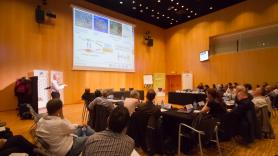4. Towards a virtual human: cells or computers
The Virtual Physiological Human (VPH) aims to study the human body based on computer-generated mathematical models. This would make it possible to not only better understand it but also to design personalized treatment plans based on our most particular characteristics.
In the words of Josep Samitier, it would be like “taking all the information available and designing a plane from its parts and systems, including a flight simulator that would let you practice flying.” In practice, ambitions aren’t as high and are limited to areas like diabetes and osteoporosis, but the goal is very ambitious and that makes it controversial.
At B·Debate, scientists from the field of biology like Ángel Raya doubted such an optimistic application of mathematical models is possible, saying that mathematics isn't enough to study the causes of a disease, the cell and the real world are also needed.
However Liesbet Geris, professor of biomechanics at the universities of Liège and Leuven and a member of the VPH project, believes that it isn't a competition, it’s a collaboration. Mathematical models use information from experimental biology. Plus, as we see in nature, “Models can also have emerging properties. This happens, for example, in gene networks, networks that can’t fit in just one head.”



